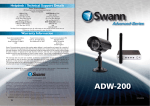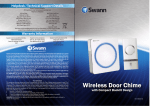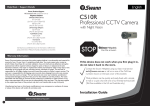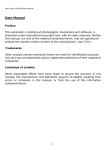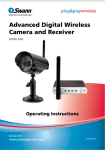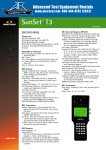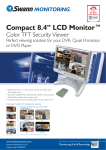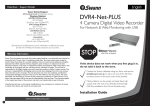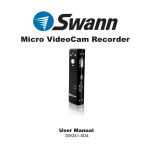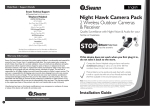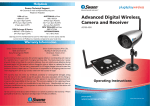Download Extra Camera for ADW-200 - Northern Tool + Equipment
Transcript
Helpdesk / Technical Support Details Swann Technical Support All Countries E-mail: [email protected] Telephone Helpdesk USA toll free 1-800-627-2799 (Su, 2pm-10pm US PT) (M-Th, 6am-10pm US PT) (F 6am-2pm US PT) USA Exchange & Repairs 1-800-627-2799 (Option 1) (M-F, 9am-5pm US PT) AUSTRALIA toll free 1300 138 324 (M 9am-5pm AUS ET) (Tu-F 1am-5pm AUS ET) (Sa 1am-9am AUS ET) NEW ZEALAND toll free 0800 479 266 UK 0203 027 0979 ™ Advanced security made easy ™ Extra Camera for ADW-200 Advanced Digital Wireless System See http://www.worldtimeserver.com for information on time zones and the current time in Melbourne, Australia compared to your local time. Warranty Information Swann Communications USA Inc. 12636 Clark Street Santa Fe Springs CA 90670 USA Swann Communications Unit 13, 331 Ingles Street, Port Melbourne Vic 3207 Swann Communications LTD. Stag Gates House 63/64 The Avenue SO171XS United Kingdom Swann Communications warrants this product against defects in workmanship and material for a period of one (1) year from it’s original purchase date. You must present your receipt as proof of date of purchase for warranty validation. Any unit which proves defective during the stated period will be repaired without charge for parts or labour or replaced at the sole discretion of Swann. The end user is responsible for all freight charges incurred to send the product to Swann’s repair centres. The end user is responsible for all shipping costs incurred when shipping from and to any country other than the country of origin. The warranty does not cover any incidental, accidental or consequential damages arising from the use of or the inability to use this product. Any costs associated with the fitting or removal of this product by a tradesman or other person or any other costs associated with its use are the responsibility of the end user. This warranty applies to the original purchaser of the product only and is not transferable to any third party. Unauthorized end user or third party modifications to any component or evidence of misuse or abuse of the device will render all warranties void. By law some countries do not allow limitations on certain exclusions in this warranty. Where applicable by local laws, regulations and legal rights will take precedence. 8 perating Ins struction Operating Instructions SW322-YDX www.swannsecurity.com © Swann Communications 2010 MYDX290410E 1 Before You Begin Troubleshooting & Technical Specifications FCC Verification: NOTE: This equipment has been tested and found to comply with the limits for Class B digital device, pursuant to part 15 of the FCC Rules. These limits are designed to provide reasonable protection against harmful interference in a residential installation. This equipment generates, uses and can radiate radio frequency energy and, if not installed and used in accordance with the instructions, may cause harmful interference to radio or television reception, which can be determined by turning the equipment off and on, the user is encouraged to try to correct the interference by one or more of the following measures: · Reorient or relocate the receiving antenna · Increase the separation between the equipment and the receiver · Connect the equipment into an outlet on a circuit different from that to which the receiver is connected · Consult the dealer or an experienced radio/TV technician for help Problem: I’m only see a blank screen where I want to see my images. Solutions: 1. Make sure that both the camera and the receiver are receiving power from their supplied power adapters. 2. Ensure that the camera is properly paired with the receiver by following the instructions on page 5. 3. Check that the channel you are displaying is the one paired with the camera. Try turning other channels off. 4. If all else fails, try moving the camera closer to the receiver, and be sure there are no obstacles (such as thick walls or metal sheets) in between the camera and the receiver blocking the signal. IMPORTANT NOTE: Prohibition against eavesdropping Except for the operations of law enforcement officers conducted under lawful authority, no person shall use, either directly or indirectly, a device operated pursuant to the provisions of this Part for the purpose of overhearing or recording the private conversations of others unless such use is authorized by all of the parties engaging in the conversation. WARNING: Modifications not approved by the party responsible for compliance could void user’s authority to operate the equipment. Problem: When I view the footage from the camera at night, I see a bright white spot and no image. Solution: Having the camera looking out a window is problematic, as the glass will reflect the infrared beams from the LEDs, over-exposing your image. Move the camera so that there are no barriers (even transparent barriers such as glass) between the camera and what you want to see. Also, make sure there are no objects within 3’/1m of the lens, as these can reflect the infrared beams as well. Problem: The image on my TV appears to be distorted. Solution: Check the PAL/NTSC settings on your television are correct for your region (NTSC for USA and Canada, PAL for Australia and Western Europe). If this does not fix the problem, check the connections between the receiver and your screen. If you are using a long RCA cable (anything over 6’/2m) try using a shorter one, particularly if there are other electrical devices located close to the TV and receiver. Problem: At night, the camera can only see 26’/8m. Solution: This is not a malfunction – this is the range of the infrared beam that the camera uses to see at night. Move the camera closer to what you wish to view. Alternately, you could purchase and install a sensor floodlight, which are available at most good hardware stores. Technical Specifications: ADW-200 IMPORTANT SAFETY INSTRUCTIONS: · Make sure product is fixed correctly and stable if fastened in place · Do not operate if wires and terminals are exposed Video Image Sensor Video Quality Number of Effective Pixels Minimum Illumination Day/Night Mode White Balance Signal / Noise Ratio Electronic Shutter NTSC, 1/50 - 15, 000 PAL Gain Control Backlight Compensation Wide Dynamic Range Lens Viewing Angle 1/4” CMOS 380 TV Lines 640 x 480 0 Lux (IR On) Color during day / switches to B&W at night Automatic < 48dB 1/60 - 1/15, 000 Automatic Yes No 6mm 53 degrees Audio Microphone Audio Range 2 Yes 9ft / 3m Night Vision Night Vision Distance Up to 26ft / 8m IR Cut Filter No Number of Infra-Red LEDs 27 Infra-Red LED Life 10, 000 hours General Indoor / Outdoor Operating Power Operating Temperature -20°C ~ 50°C Body Construction Dimensions - Camera & Stand Wireless Digital or Analog Max. Transmission Range Typical Range Frequency Transmission Channels Both DC 5V -4°F ~ 122°F / Aluminium 5.1” x 3.7” x 2.4” / 130mm x 95mm x 60mm Digital Up to 165ft / 50m 65ft / 20m 2.4 GHz (FHSS) 4 7 Connection Guide Table of Contents Note that this connection diagram assumes that you have all the components which came with the ADW-200 set containing the receiver. Steps 3 ~ 12 refer to the connection of the receiver. If you’ve already set up the receiver and are just adding another camera, only steps 1 & 2 are relevant. 1 Before You Begin 2 Table of Contents 3 Package Contents 3 Overview & Layout 4 Pairing & Active Channels 5 Connection Guide 6 Technical Specifications & Troubleshooting 7 2 4 Connecting the Camera 1. Connect the antenna to the rear of the camera. 2. Connect the supplied power adapter (5V) to the power input on the camera, and plug the power adapter in to a wall socket. 6 Connecting the Receiver Helpdesk / Warranty Information 5 8 Input 4. Connect the power adaptor to the power input on the rear of the receiver. Rear Cover 9 DVR VCR or DVD recorder Input Output 3. 3 Output 10 7 Connect the A/V cable to the A/V OUT port on the rear of the receiver (the plug looks like a miniature headphone jack). Package Contents 12 Connecting to a VCR / DVD Recorder Television 5. Connect the yellow VIDEO OUT plug to the VIDEO IN port (usually also yellow) on your VCR/DVD recorder. 6. If you want to monitor/record audio, then plug the white AUDIO OUT plug into the AUDIO IN port (also typically white) on the VCR/DVD recorder. 7. Connect the Video/Audio OUT of the VCR/DVD recorder to a TV as detailed below. 8. Attach the yellow VIDEO OUT plug to one of the INPUTS on the rear of the DVR. If your DVR uses BNC connectors, you’ll need to use a BNC/RCA adaptor (as pictured in the diagram). Most DVRs use BNC plugs. 9. If DVR supports audio, then you can plug the white AUDIO OUT plug to an AUDIO INPUT on the rear of the DVR. These typically use RCA plugs and won’t need an adaptor - but exceptions to this rule exist. 11 INPUT 1 INPUT 3 OUTPUT ADW-200 Camera 5V Power Adapter Camera Stand Operating Instructions Antenna Mounting Hardware Connecting to a DVR 10. Connect the AUDIO and VIDEO OUTPUTS to your TV. Consult your DVR’s manual for more information regarding connecting a monitor to your DVR. Connecting directly to a TV 11. Connect the yellow VIDEO OUT plug to a VIDEO IN port (usually yellow as well) on the TV you want to use. Avoid component inputs (which are color coded red, green and blue) as these use a very different type of video signal. 12. If you want to monitor audio, the connect the white AUDIO OUT plug to an AUDIO INPUT on the TV. 6 3 Overview & Layout Pairing & Active Channels Expanding your Digital Wireless monitoring capabilities! The Pairing Button This extra camera for the ADW-200 system is a high quality yet cost effective way to expand and improve your digital wireless monitoring system. Up to four (4) ADW-200 cameras can be paired with a single receiver. The ADW-200 uses a secure digital transmission, greatly increasing the integrity and privacy of your images. This, however, does mean that the ADW-200 camera is not compatible with other wireless systems, whether they be digital or analog. Each camera you use will need to be paired with one channel on the receiver. A camera can only be paired to one channel at a time, and one channel can only have one camera paired with it. Thus, pairing a channel to a camera will replace any camera previously paired with it. This digital wireless camera is compatible with the ADW-200 receiver only! • • • For more information about the ADW-200 receiver, see the manual which came with the receiver. This manual contains only the information required to connect an additional camera to a previously installed ADW-200 system. • When Placing Multiple Cameras Antenna Light Sensor Lens When two or more digital wireless cameras are placed too close together, the receiver can have difficulty distinguishing between the two signals, for much the same reason as it would be difficult to listen to two people standing side by side and both talking at the same volume. Keep your cameras as far apart as possible – ideally, at least 6 ~ 9 feet (perhaps 2 ~ 3m). Infrared LEDs Stand The result of two cameras too near one another will be a reduction in quality of your picture, with the possibility of a slight pause when changing channels. If you are experiencing these problems and simply cannot move cameras apart, then try orienting the antennas away from one another. This will not have as dramatic an effect as actually moving the camera, but often can provide somewhat of an improvement. Tips & Tricks: The best image possible To help improve the clarity and frame rate of your images: • Reduce the number of obstacles between the camera and receiver. Ideally, there should be a clear line of sight from one to the other. • Keep the cameras and receiver away from devices which make a lot of radio “noise” such as wireless routers and microwaves. • Try to avoid environments with thick brick and concrete walls, as well as areas with large amounts of metals. 4 Pairing Cameras Activate the channel you want to pair a camera to (see below). Use the CH button to set the receiver to the channel you want to pair to. Press and hold the CH button until the LED on the front of the receiver begins to flash rapidly. Quickly press the pairing button on the power cable of the camera you want to pair to this channel. The red LEDs on the front of the receiver will let you know which channel you have selected, what state that channel is in. Channels which are turned off will not be selectable, and the LED will stay off. Always On: The channel in question is selected, and has an active camera paired with it. Flashing Slowly: The channel is selected but cannot detect a camera which has been paired with it. This could happen if you’ve re-paired the camera to a different channel, or you’ve activated a channel without pairing a camera to it. Flashing Quickly: The channel is in pairing mode, awaiting the pairing signal from a camera. Active Channels The ADW-200 receiver can potentially support up to four cameras. It cannot display all of these at a time, however. Rather, you can use Loop Mode, which will sequentially display images from one camera at a time. As you can have between one and four cameras paired with the receiver, you’ll need to set how many channels are active, and which channels they are. Located on the rear of the receiver you’ll find a series of DIP switches. These are labelled from 1 to 4, with a fifth switch named “L”. The switches 1 ~ 4 activate each channel. A channel is ON when the switch is in the downwards position, as indicated in the diagram. The switch marked “L” toggles loop mode on or off. 1 2 ON 3 4 L In this example, channels 1 and 2 have been activated, and the receiver set to Loop Mode. Thus, channel 1 will be displayed, then the display will switch to channel 2 and then back again. Channels 3 & 4 will not be shown. 5 Overview & Layout Pairing & Active Channels Expanding your Digital Wireless monitoring capabilities! The Pairing Button This extra camera for the ADW-200 system is a high quality yet cost effective way to expand and improve your digital wireless monitoring system. Up to four (4) ADW-200 cameras can be paired with a single receiver. The ADW-200 uses a secure digital transmission, greatly increasing the integrity and privacy of your images. This, however, does mean that the ADW-200 camera is not compatible with other wireless systems, whether they be digital or analog. Each camera you use will need to be paired with one channel on the receiver. A camera can only be paired to one channel at a time, and one channel can only have one camera paired with it. Thus, pairing a channel to a camera will replace any camera previously paired with it. This digital wireless camera is compatible with the ADW-200 receiver only! • • • For more information about the ADW-200 receiver, see the manual which came with the receiver. This manual contains only the information required to connect an additional camera to a previously installed ADW-200 system. • When Placing Multiple Cameras Antenna Light Sensor Lens When two or more digital wireless cameras are placed too close together, the receiver can have difficulty distinguishing between the two signals, for much the same reason as it would be difficult to listen to two people standing side by side and both talking at the same volume. Keep your cameras as far apart as possible – ideally, at least 6 ~ 9 feet (perhaps 2 ~ 3m). Infrared LEDs Stand The result of two cameras too near one another will be a reduction in quality of your picture, with the possibility of a slight pause when changing channels. If you are experiencing these problems and simply cannot move cameras apart, then try orienting the antennas away from one another. This will not have as dramatic an effect as actually moving the camera, but often can provide somewhat of an improvement. Tips & Tricks: The best image possible To help improve the clarity and frame rate of your images: • Reduce the number of obstacles between the camera and receiver. Ideally, there should be a clear line of sight from one to the other. • Keep the cameras and receiver away from devices which make a lot of radio “noise” such as wireless routers and microwaves. • Try to avoid environments with thick brick and concrete walls, as well as areas with large amounts of metals. 4 Pairing Cameras Activate the channel you want to pair a camera to (see below). Use the CH button to set the receiver to the channel you want to pair to. Press and hold the CH button until the LED on the front of the receiver begins to flash rapidly. Quickly press the pairing button on the power cable of the camera you want to pair to this channel. The red LEDs on the front of the receiver will let you know which channel you have selected, what state that channel is in. Channels which are turned off will not be selectable, and the LED will stay off. Always On: The channel in question is selected, and has an active camera paired with it. Flashing Slowly: The channel is selected but cannot detect a camera which has been paired with it. This could happen if you’ve re-paired the camera to a different channel, or you’ve activated a channel without pairing a camera to it. Flashing Quickly: The channel is in pairing mode, awaiting the pairing signal from a camera. Active Channels The ADW-200 receiver can potentially support up to four cameras. It cannot display all of these at a time, however. Rather, you can use Loop Mode, which will sequentially display images from one camera at a time. As you can have between one and four cameras paired with the receiver, you’ll need to set how many channels are active, and which channels they are. Located on the rear of the receiver you’ll find a series of DIP switches. These are labelled from 1 to 4, with a fifth switch named “L”. The switches 1 ~ 4 activate each channel. A channel is ON when the switch is in the downwards position, as indicated in the diagram. The switch marked “L” toggles loop mode on or off. 1 2 ON 3 4 L In this example, channels 1 and 2 have been activated, and the receiver set to Loop Mode. Thus, channel 1 will be displayed, then the display will switch to channel 2 and then back again. Channels 3 & 4 will not be shown. 5 Connection Guide Table of Contents Note that this connection diagram assumes that you have all the components which came with the ADW-200 set containing the receiver. Steps 3 ~ 12 refer to the connection of the receiver. If you’ve already set up the receiver and are just adding another camera, only steps 1 & 2 are relevant. 1 Before You Begin 2 Table of Contents 3 Package Contents 3 Overview & Layout 4 Pairing & Active Channels 5 Connection Guide 6 Technical Specifications & Troubleshooting 7 2 4 Connecting the Camera 1. Connect the antenna to the rear of the camera. 2. Connect the supplied power adapter (5V) to the power input on the camera, and plug the power adapter in to a wall socket. 6 Connecting the Receiver Helpdesk / Warranty Information 5 8 Input 4. Connect the power adaptor to the power input on the rear of the receiver. Rear Cover 9 DVR VCR or DVD recorder Input Output 3. 3 Output 10 7 Connect the A/V cable to the A/V OUT port on the rear of the receiver (the plug looks like a miniature headphone jack). Package Contents 12 Connecting to a VCR / DVD Recorder Television 5. Connect the yellow VIDEO OUT plug to the VIDEO IN port (usually also yellow) on your VCR/DVD recorder. 6. If you want to monitor/record audio, then plug the white AUDIO OUT plug into the AUDIO IN port (also typically white) on the VCR/DVD recorder. 7. Connect the Video/Audio OUT of the VCR/DVD recorder to a TV as detailed below. 8. Attach the yellow VIDEO OUT plug to one of the INPUTS on the rear of the DVR. If your DVR uses BNC connectors, you’ll need to use a BNC/RCA adaptor (as pictured in the diagram). Most DVRs use BNC plugs. 9. If DVR supports audio, then you can plug the white AUDIO OUT plug to an AUDIO INPUT on the rear of the DVR. These typically use RCA plugs and won’t need an adaptor - but exceptions to this rule exist. 11 INPUT 1 INPUT 3 OUTPUT ADW-200 Camera 5V Power Adapter Camera Stand Operating Instructions Antenna Mounting Hardware Connecting to a DVR 10. Connect the AUDIO and VIDEO OUTPUTS to your TV. Consult your DVR’s manual for more information regarding connecting a monitor to your DVR. Connecting directly to a TV 11. Connect the yellow VIDEO OUT plug to a VIDEO IN port (usually yellow as well) on the TV you want to use. Avoid component inputs (which are color coded red, green and blue) as these use a very different type of video signal. 12. If you want to monitor audio, the connect the white AUDIO OUT plug to an AUDIO INPUT on the TV. 6 3 Before You Begin Troubleshooting & Technical Specifications FCC Verification: NOTE: This equipment has been tested and found to comply with the limits for Class B digital device, pursuant to part 15 of the FCC Rules. These limits are designed to provide reasonable protection against harmful interference in a residential installation. This equipment generates, uses and can radiate radio frequency energy and, if not installed and used in accordance with the instructions, may cause harmful interference to radio or television reception, which can be determined by turning the equipment off and on, the user is encouraged to try to correct the interference by one or more of the following measures: · Reorient or relocate the receiving antenna · Increase the separation between the equipment and the receiver · Connect the equipment into an outlet on a circuit different from that to which the receiver is connected · Consult the dealer or an experienced radio/TV technician for help Problem: I’m only see a blank screen where I want to see my images. Solutions: 1. Make sure that both the camera and the receiver are receiving power from their supplied power adapters. 2. Ensure that the camera is properly paired with the receiver by following the instructions on page 5. 3. Check that the channel you are displaying is the one paired with the camera. Try turning other channels off. 4. If all else fails, try moving the camera closer to the receiver, and be sure there are no obstacles (such as thick walls or metal sheets) in between the camera and the receiver blocking the signal. IMPORTANT NOTE: Prohibition against eavesdropping Except for the operations of law enforcement officers conducted under lawful authority, no person shall use, either directly or indirectly, a device operated pursuant to the provisions of this Part for the purpose of overhearing or recording the private conversations of others unless such use is authorized by all of the parties engaging in the conversation. WARNING: Modifications not approved by the party responsible for compliance could void user’s authority to operate the equipment. Problem: When I view the footage from the camera at night, I see a bright white spot and no image. Solution: Having the camera looking out a window is problematic, as the glass will reflect the infrared beams from the LEDs, over-exposing your image. Move the camera so that there are no barriers (even transparent barriers such as glass) between the camera and what you want to see. Also, make sure there are no objects within 3’/1m of the lens, as these can reflect the infrared beams as well. Problem: The image on my TV appears to be distorted. Solution: Check the PAL/NTSC settings on your television are correct for your region (NTSC for USA and Canada, PAL for Australia and Western Europe). If this does not fix the problem, check the connections between the receiver and your screen. If you are using a long RCA cable (anything over 6’/2m) try using a shorter one, particularly if there are other electrical devices located close to the TV and receiver. Problem: At night, the camera can only see 26’/8m. Solution: This is not a malfunction – this is the range of the infrared beam that the camera uses to see at night. Move the camera closer to what you wish to view. Alternately, you could purchase and install a sensor floodlight, which are available at most good hardware stores. Technical Specifications: ADW-200 IMPORTANT SAFETY INSTRUCTIONS: · Make sure product is fixed correctly and stable if fastened in place · Do not operate if wires and terminals are exposed Video Image Sensor Video Quality Number of Effective Pixels Minimum Illumination Day/Night Mode White Balance Signal / Noise Ratio Electronic Shutter NTSC, 1/50 - 15, 000 PAL Gain Control Backlight Compensation Wide Dynamic Range Lens Viewing Angle 1/4” CMOS 380 TV Lines 640 x 480 0 Lux (IR On) Color during day / switches to B&W at night Automatic < 48dB 1/60 - 1/15, 000 Automatic Yes No 6mm 53 degrees Audio Microphone Audio Range 2 Yes 9ft / 3m Night Vision Night Vision Distance Up to 26ft / 8m IR Cut Filter No Number of Infra-Red LEDs 27 Infra-Red LED Life 10, 000 hours General Indoor / Outdoor Operating Power Operating Temperature -20°C ~ 50°C Body Construction Dimensions - Camera & Stand Wireless Digital or Analog Max. Transmission Range Typical Range Frequency Transmission Channels Both DC 5V -4°F ~ 122°F / Aluminium 5.1” x 3.7” x 2.4” / 130mm x 95mm x 60mm Digital Up to 165ft / 50m 65ft / 20m 2.4 GHz (FHSS) 4 7 Helpdesk / Technical Support Details Swann Technical Support All Countries E-mail: [email protected] Telephone Helpdesk USA toll free 1-800-627-2799 (Su, 2pm-10pm US PT) (M-Th, 6am-10pm US PT) (F 6am-2pm US PT) USA Exchange & Repairs 1-800-627-2799 (Option 1) (M-F, 9am-5pm US PT) AUSTRALIA toll free 1300 138 324 (M 9am-5pm AUS ET) (Tu-F 1am-5pm AUS ET) (Sa 1am-9am AUS ET) NEW ZEALAND toll free 0800 479 266 UK 0203 027 0979 ™ Advanced security made easy ™ Extra Camera for ADW-200 Advanced Digital Wireless System See http://www.worldtimeserver.com for information on time zones and the current time in Melbourne, Australia compared to your local time. Warranty Information Swann Communications USA Inc. 12636 Clark Street Santa Fe Springs CA 90670 USA Swann Communications Unit 13, 331 Ingles Street, Port Melbourne Vic 3207 Swann Communications LTD. Stag Gates House 63/64 The Avenue SO171XS United Kingdom Swann Communications warrants this product against defects in workmanship and material for a period of one (1) year from it’s original purchase date. You must present your receipt as proof of date of purchase for warranty validation. Any unit which proves defective during the stated period will be repaired without charge for parts or labour or replaced at the sole discretion of Swann. The end user is responsible for all freight charges incurred to send the product to Swann’s repair centres. The end user is responsible for all shipping costs incurred when shipping from and to any country other than the country of origin. The warranty does not cover any incidental, accidental or consequential damages arising from the use of or the inability to use this product. Any costs associated with the fitting or removal of this product by a tradesman or other person or any other costs associated with its use are the responsibility of the end user. This warranty applies to the original purchaser of the product only and is not transferable to any third party. Unauthorized end user or third party modifications to any component or evidence of misuse or abuse of the device will render all warranties void. By law some countries do not allow limitations on certain exclusions in this warranty. Where applicable by local laws, regulations and legal rights will take precedence. 8 perating Ins struction Operating Instructions SW322-YDX www.swannsecurity.com © Swann Communications 2010 MYDX290410E 1









